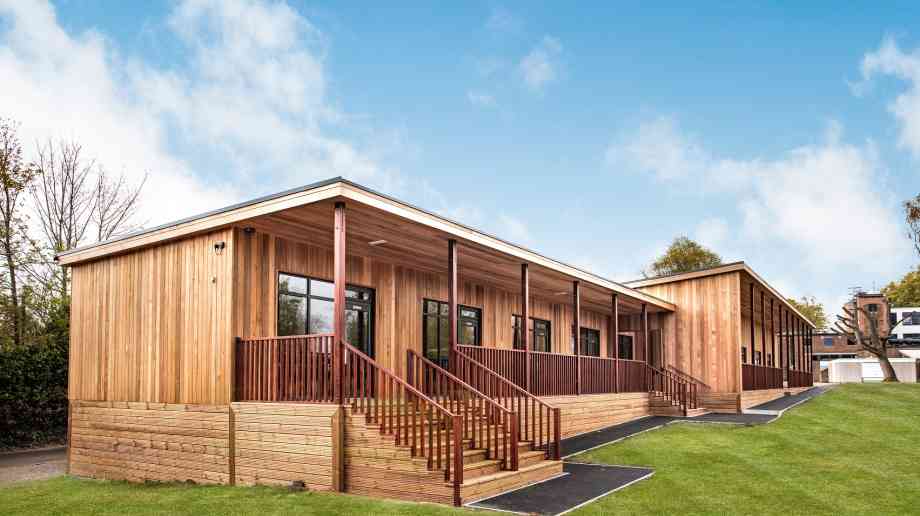
Net zero – the future of education buildings
Image shows Eco Sixth Form Centre at King Edward VI Handsworth Wood Girls Academy by TG Escapes
Recognising and finding ways to meet the requirements of changing regulations and policy demands is crucial in reshaping our approach to sustainability. The ecological clock is ticking, and we must take urgent action to mitigate the impact of global warming. Here Richard Hipkiss, development director of the Modular and Portable Building Association (MPBA) makes a case for volumetric manufactured buildings in shaping a net zero future
We have a proud legacy of innovation in the modular and portable building sector and many of our members are gearing up to face the biggest challenge of our generation – the climate crisis. In order to prevent the global temperature rising beyond 1.5°C and avoid the worst impacts of climate change, the world needs to reach net zero emissions before 2050.
So, what is net zero? Put simply net zero is a target of negating the amount of greenhouse gases we produce by reducing emissions and implementing methods of absorbing carbon dioxide from the atmosphere.
Our government has set out a vision for the education sector to be world leading in sustainability and climate change by 2030. All new school buildings delivered by the Department for Education (DfE) that are not already contracted will be net zero in operation. They will be designed for a 2°C rise in average global temperatures and future-proofed for a 4°C rise, to adapt to the risks of climate change, including increased flooding and higher indoor temperatures.
Framework
In November 2021, the DfE published a delivery framework so that all new schools and colleges can meet the same low-carbon, climate-resilient standards as centrally delivered projects. From now on, bids into the government’s Further Education Capital Transformation Programme will also be assessed to determine if the new works will be net zero in operation.
The DfE is aware that higher education institutions are already demonstrating innovation in this space and will look to the higher education sector to inspire and drive greater ambition through their net zero buildings and campuses. By 2023, all bids for capital funding for further education and higher education will need to consider environmental impact, carbon reduction and adaptation measures, and align with the government’s targets and objectives.
With great challenges come opportunities and the construction sector is setting out road maps to deliver buildings that will be net zero in operation, but this is only part of the carbon equation.
According to the World Green Building Council, construction and buildings in use are responsible for 39 per cent of all carbon emissions in the world. This is broken down into two elements with 11 per cent being linked to the manufacture of materials and construction processes known as embodied carbon emissions and 28 per cent associated with operational emissions caused by heating, cooling and lighting systems when a building is in use.
The challenge is therefore two-fold. Whilst there has been a drive to reduce operational emissions through the implementation of government legislation to improve the building fabric and the wider use of innovative technologies – little has been done to address the carbon inefficiencies in the construction process.
Game changer
As an industry association it is one of our objectives to demonstrate how the route to 2050 could follow a number of different paths. It is now established that volumetric modular approaches are a game changer for the construction industry – reducing build times by an impressive 50-60 per cent whilst increasing quality, productivity and safety. But what is not so widely understood is that compared to traditionally built projects it is easier to control energy use in factory settings than in an open construction site. On average 67 per cent less energy is required to produce a volumetric manufactured building and up to 50 per cent less time is spent onsite, resulting in up to 90 per cent fewer vehicle movements which is less disruptive and reduces carbon emissions.
Individual modules are produced in factory settings, which allows better control over optimising material use. The surplus materials are recycled or reused for future projects, reducing the construction waste that ends up in landfill. Materials are protected from moisture and extreme weather conditions, reducing the risk of disposal through water ingress and damage. It is widely recognised that modular has the potential to reduce overall construction programmes, but it is not often acknowledged this approach can reduce up to 90 per cent of waste generated when compared with traditional construction methods.
Not only is the actual construction of the building ‘greener’ but volumetric manufactured buildings are also more energy efficient – reducing primary energy requirements and in-use operational emissions during the lifetime of the building.
Unlike factory manufactured buildings, there is significant evidence that traditional construction methods do not produce structures that perform as well as design expectations and there is a void between anticipated and actual in-use performance. Findings from studies such as PROBE (Post Occupancy Review of Buildings and their Engineering) reveal that actual energy consumption in buildings is often as much as twice of that predicted in the design.
Volumetric modular buildings however are less susceptible to poorly specified products as time can be taken upfront to validate the correct specification of materials. Designs are digitally constructed and virtually tested before they move onto the manufacturing phase. Predictability of in-use performance is a substantial benefit in achieving net zero goals.
A key advantage of modular construction is the quality benefits which come from working in a controlled factory environment. By producing buildings in a factory setting, the quality of elements such as insulation can be better assured.
We need to act now to help mitigate the impact of climate change for future generations to come. As the construction sector develops and adapts to meet changing government strategies and net zero targets, I firmly believe the upward trajectory of volumetric modular buildings will continue to rise.
The benefits of volumetric manufactured buildings begin in the factory, continue on to the construction site and last through the lifetime of the building. The volumetric modular way limits the amount of concrete in the ground and eco-friendly materials are often specified and each individual component can be selected specifically for its performance characteristics, tailoring every inch of a volumetric modular build.
The MPBA plays a key role in the connecting of sectors in the modular and portable building industry. The association collaborates with specialist technical advisors to enhance innovation in the design and manufacture of volumetric modular buildings. These can be designed and manufactured from timber or steel in any size and shape to meet individual client needs while ensuring full compliance with Building Regulations. To discover how volumetric modular technology can benefit construction projects, visit www.mpba.biz.
Latest News
19/12/2025 - 09:54
The Education Committee has expanded its ongoing inquiry into the early years sector to examine how safeguarding can be strengthened in early years settings.
18/12/2025 - 09:25
The UK will be rejoining the Erasmus programme in 2027, following a package of agreements with the EU.
17/12/2025 - 09:31
Ofqual has fined exam board Pearson more than £2 million in total for serious breaches in three separate cases between 2019 and 2023 which collectively affected tens of thousands of students.
16/12/2025 - 09:19
The average funding rates will increase by 4.3% for under 2s, and by almost 5% for 3-and-4-year-olds.
15/12/2025 - 10:30
Local colleges are set to receive £570 million in government funding to expand training facilities in areas such as construction and engineering.







